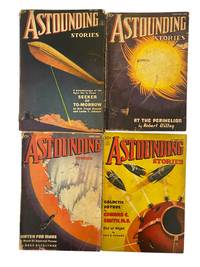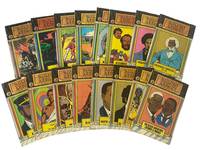by Black History, Vinyl
[Civil Rights] [African American] [Slavery and Abolition] A complete set of the Adventures in Negro History educational LP series, created to promote Black history and culture during the Civil Rights era through dramatized narration and scholarly commentary. Adventures in Negro History: Volumes I–III. Highlight Radio Productions, 1963, 1966, 1969. Three original 12-inch 33⅓ rpm vinyl LPs, each record housed in original illustrated jacket. Commissioned by Pepsi-Cola and produced by the Chicago-based Highlight Radio Productions, this project brought together historians, actors, and community leaders in an accessible, audio-driven public history format. Each volume explores a distinct theme in African American experience, with powerful graphic covers and scholarly liner notes by eminent historians John Hope Franklin and Elsie M. Lewis.
[1] Volume I: Adventures in Negro History (1963). Illustrated in stark black and white, the cover features a stylized portrait of a bound enslaved man, visually evoking the violent conditions of enslavement and the struggle for freedom. The back cover provides capsule biographies of pivotal figures, including Estevanico, Crispus Attucks, and W.E.B. Du Bois, as well as dramatizations of "Douglass!" and "Pinchback!" The LP includes dramatized reenactments written and directed by Ossie Davis, and is voiced by Ruby Dee, Godfrey Cambridge, Brock Peters, and Roy Glenn. The liner text opens: “We cannot afford to let the story of Negro Americans—who they were, how they lived, what they did—go untold. This is a job that needs doing in all the classrooms of America.” The tone is urgent and pedagogical, designed to be played in schools, libraries, and community centers.
[2] Volume II: The Frederick Douglass Years, 1817–1895 (1966).With a bold blue cover echoing the design of Volume I, this LP focuses entirely on Douglass’s life, from enslavement to abolitionist leader. A full panel on the reverse contains the essay What the Douglass Years Mean to America by John Hope Franklin, then Professor of American History at the University of Chicago. Franklin writes: “The Frederick Douglass story is the story of America in the nineteenth century… it is the story of man’s struggle for justice and liberty in a society often committed more to self-interest than to high principle.” The dramatizations include scenes from Douglass’s escape from slavery, his debates with white abolitionists, and his role during Reconstruction. The same acclaimed voice cast from Volume I returns.
[3] Volume III: The Afro-American’s Quest for Education – A Black Odyssey (1969).This volume shifts focus to the historical struggle for Black educational access, from slavery through desegregation. The cover, rendered in burnt sienna and black, features a graphic portrait of a bearded elder flanked by line drawings of teachers, students, and historic Black institutions. On the verso, Dr. Elsie M. Lewis, Professor of History at Howard University, contributes a major essay, declaring: “No phase of the American Negro’s history is more crucial, more dramatic or more moving than his long, dogged quest for education.” Her commentary frames education as both a right and revolutionary act for African Americans. Like earlier entries, Volume III blends narrative scenes with documentary-style commentary.
All three LPs are in very good condition with minor edge wear to sleeves. Vinyl appears clean with no visible scratches. These records were not mass-marketed and were distributed largely through educational and community networks, making complete sets scarce. (Inventory #: 22170)
[1] Volume I: Adventures in Negro History (1963). Illustrated in stark black and white, the cover features a stylized portrait of a bound enslaved man, visually evoking the violent conditions of enslavement and the struggle for freedom. The back cover provides capsule biographies of pivotal figures, including Estevanico, Crispus Attucks, and W.E.B. Du Bois, as well as dramatizations of "Douglass!" and "Pinchback!" The LP includes dramatized reenactments written and directed by Ossie Davis, and is voiced by Ruby Dee, Godfrey Cambridge, Brock Peters, and Roy Glenn. The liner text opens: “We cannot afford to let the story of Negro Americans—who they were, how they lived, what they did—go untold. This is a job that needs doing in all the classrooms of America.” The tone is urgent and pedagogical, designed to be played in schools, libraries, and community centers.
[2] Volume II: The Frederick Douglass Years, 1817–1895 (1966).With a bold blue cover echoing the design of Volume I, this LP focuses entirely on Douglass’s life, from enslavement to abolitionist leader. A full panel on the reverse contains the essay What the Douglass Years Mean to America by John Hope Franklin, then Professor of American History at the University of Chicago. Franklin writes: “The Frederick Douglass story is the story of America in the nineteenth century… it is the story of man’s struggle for justice and liberty in a society often committed more to self-interest than to high principle.” The dramatizations include scenes from Douglass’s escape from slavery, his debates with white abolitionists, and his role during Reconstruction. The same acclaimed voice cast from Volume I returns.
[3] Volume III: The Afro-American’s Quest for Education – A Black Odyssey (1969).This volume shifts focus to the historical struggle for Black educational access, from slavery through desegregation. The cover, rendered in burnt sienna and black, features a graphic portrait of a bearded elder flanked by line drawings of teachers, students, and historic Black institutions. On the verso, Dr. Elsie M. Lewis, Professor of History at Howard University, contributes a major essay, declaring: “No phase of the American Negro’s history is more crucial, more dramatic or more moving than his long, dogged quest for education.” Her commentary frames education as both a right and revolutionary act for African Americans. Like earlier entries, Volume III blends narrative scenes with documentary-style commentary.
All three LPs are in very good condition with minor edge wear to sleeves. Vinyl appears clean with no visible scratches. These records were not mass-marketed and were distributed largely through educational and community networks, making complete sets scarce. (Inventory #: 22170)




